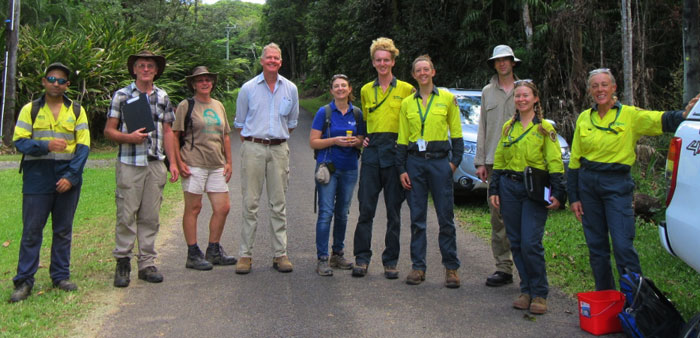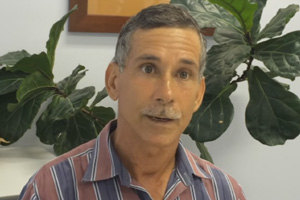
My guide, a birdwatcher, couldn’t disguise his excitement at the return of life we were seeing all around us. The rainforest at Russett Park in Kuranda was once eerily quiet, but now, in a place where birds and insects had been stripped away, they are returning.
Yellow crazy ants had denuded this tropical rainforest of its most vibrant lifeforms. The ants, most likely introduced through the careless movement of soil, had infested the area of rainforest bordering the Barron River and from there these rafting ants spread downstream to take over new sites.
In the middle of a typically wet north Queensland summer we are seeing plenty of evidence that the yellow crazy ant eradication program is hitting its straps. Native green ants are returning, as are azure kingfishers, and the number of yellow crazy ants being caught in survey bait traps is falling.
How did this happen?
The volunteer, community-based Kuranda Envirocare, working with funding from Terrain NRM, mobilised a extraordinary and highly effective response to this serious environmental invader.
Coordinating volunteers, green army teams, indigenous rangers, in-kind contributions from council, and advice from the Wet Tropics Management Authority and James Cook University, the yellow crazy ant community taskforce has contained and reduced the local yellow crazy ant infestation.
The key to the community taskforce’s success has been letting community volunteers and local property owners lead on-ground surveillance and control work backed up by professional scientific advice. It’s a model that has great application elsewhere.
For such an ambitious program, setbacks are part and parcel of the job. They are not considered a reason for ending the program but instead treated as lessons from which to build.
The program continually fine tunes its awareness efforts, to aid both surveillance and improve quarantine measures. It is this openness of the community taskforce to review its own processes and its ability to deliver a creative community-led response that means their model deserves replication.
Townsville infestation
Beyond Kuranda, the prospects of eradicating yellow crazy ants from the much larger infestation in the Cairns region remain positive, but only if full funding is maintained to support eradication efforts led by the Wet Tropics Management Authority. What is extremely worrying is the range of other yellow crazy ant infestations in Queensland that are receiving no attention at all.
At Nome, south of Townsville, a 40 hectare infestation was essentially ignored until January this year. We visited the property in December last year when ant densities were very high and the ants were infiltrating not just local bushland but residential premises as well.
The Townsville City Council, with advice from CSIRO, conducted a full survey of the site and applied for funding through Queensland’s Feral Pest Initiative to conduct a quarantine and control program. The funding application was successful but the funds can only be used for survey work, work the council has already carried out.
This is a perfect example of a site where a community-led eradication modelled on the Kuranda Envirocare approach would be very cost effective.
One step from Fraser Island
Yellow crazy ants have also been found at Hervey Bay, approximately 400km north of Brisbane and just a short boat trip from the World Heritage-listed Fraser Island.
We know the infestation was treated in 2012, but have yet to obtain results of the last crazy ant survey conducted in the region. The infestation was close to Hervey Bay marina, a natural stepping stone for the ants if they were to ever invade Fraser Island. If that ever happens, we can expect a huge loss of native wildlife.
Brisbane has also seen many yellow crazy ant infestations, but again little to no surveillance work is occurring, even in relation to wetlands, bushland corridors and nature reserves.
Part of the solution
The Kuranda experience, which mobilises community and science-based forces as part of a broad-reaching pincer movement against dangerous new invasive species like yellow crazy ants, is clearly a model that could be taken up across Queensland and the rest of Australia.
Property owners, community groups and volunteer teams working together with the support of local governments, natural resource management groups and scientific experts can create a highly effective force in the fight against invasive species.
Making communities part of the solution creates local interest in protecting their patch of bushland, coastal area or marine hotspot, and may be the only realistic way we can deal with the volume of invasive species threats emerging in Australia.
The Kuranda Envirocare team are continuing their work in the rainforest. What they are doing should be an inspiration for us all.



